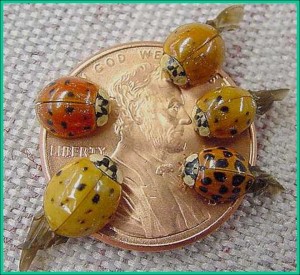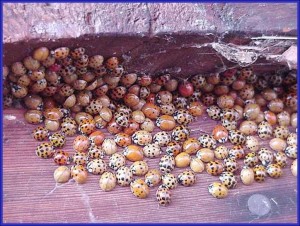
Multicolored Asian Lady beetle
THESE LADYBUGS ARE DRIVING ME CRAZY!
Howard Russell, MSU – Diagnostic Services
Christine DiFonzo, MSU – Department of Entomology
Hundreds, sometimes thousands, of lady beetles are gathering around homes and other structures as autumn gets under way in Michigan. This lady beetle, or ladybug, is the Multicolored Asian Lady beetle, Harmonia axyridis, and it is driving people buggy throughout the state. During the fall, the beetle congregates on the sides of buildings, enters homes and lands on folks as they walk through their yards, and it sometimes bites. The multicolored Asian lady beetle can be easily distinguished from other species of lady beetles by the presence of a black M-shaped pattern directly behind the head. Adults are large for lady beetles and are about 1/4 inch long and 3/16 inch wide. Coloration varies from bright orange with up to 19 black spots in some individuals to dull yellow with pale or no visible spots on others (hence their common name).
Female beetles lay yellow, oval-shaped eggs in clusters on the underside of leaves where aphids are present. The eggs hatch into soft-bodied larvae with long legs and are black in color with red- orange markings. The larvae are voracious and consume many aphids and scale crawlers during this stage of development. They eventually form pupae that are attached to plant leaves. Adults emerge from the pupae and begin feeding, mating and laying eggs. Several generations are produced each summer. These adults can be found on a wide variety of trees including apple, maple, oak, pine, and poplar. Adults can live up to 3 years.
The multicolored Asian lady beetle is a native of Asia. There were several attempts to introduce the beetle into the southeastern and southwestern portions of the United States to help control aphids on pecan trees back in the late 70’s. Some say that none of these deliberate attempts succeeded, but that the beetle became established after ‘jumping ship’ somewhere along the Gulf coast. Since then it has spread rapidly throughout the US and southern Canada. It was first found in Ontario in 1992. Despite popular rumors, the beetle was not released by the DNR, MSU, or chemical companies. One reason that might explain their large numbers is our newest aphid pest, the soybean aphid. This aphid was discovered in Michigan and other Midwestern states during the summer of 2000. Thousands of these aphids can occur on a single soybean plant and the Asian Multicolored Lady beetle is taking advantage of this unlimited food source. Soybean aphid populations were very high in 2001 (the last time we saw large populations of the Asian lady beetle), and again this past summer. Many of the soybean plants examined at our diagnostic lab have had a dozen or so lady beetle larvae munching away on the hapless aphids. There are multiple generations of the beetle during the summer and the adults can live up to three years.
The lady beetle is known primarily as a tree-dwelling species, but it can be found on almost any plant where aphids occur. The beetle has also been reported to eat shallow holes in ripening peaches, apples, and other fruit. During the fall of the year, many people complain the beetles bite, which in fact they do. These ‘bites’ are very different from the bite of a mosquito and other blood sucking parasites. The bite of the Multicolored Asian Lady beetle is more like a pinch and no blood meal is taken. The bite can be painful and very annoying if many of the beetles are present.
The Multicolored Asian Lady Beetle is a nuisance pest because the adults tend to congregate and overwinter inside buildings in large numbers. Some bug people say the beetle does this because in their homeland of China they inhabit tall cliffs to overwinter and that buildings are the closest thing we have to tall cliffs in Michigan. To make matters worse, they supposedly release a pheromone that attracts more beetles to the same area. Although these lady beetles may bite, this bite does not seriously injure humans or spread diseases. If crushed, the beetles will emit a foul odor and leave a stain. The dust produced from an accumulation of dead Multicolored Asian Lady Beetles behind wall voids may trigger allergies or asthma in people.
The beetles do not breed or reproduce indoors. They are attracted to lights and light-colored buildings, especially the south side where it is warm. The beetles then work their way into buildings through soffit vents, openings around windows, and other cracks and crevices in the building’s exterior finish. Once inside the walls and ceilings, the beetles find their way into the living space through openings in the building’s interior walls such as outlets, switches, heating/cooling vents, and ceiling fixtures. Dark-colored buildings are reported to generally have fewer problems with the beetles.
Beetles might be prevented from entering homes by caulking or sealing cracks and crevices. This can be difficult, if not impossible, to accomplish in some homes. If sealing the exterior walls does not help, then caulking around outlet and switch boxes, ceiling fixtures, heat ducts and other openings in interior wall will at least keep the beetles in the walls and out of the living space. Sweeping or vacuuming can remove beetles already in homes. Be sure to empty the vacuum bags afterward. Commercially available indoor insect light traps can also be effective.
In kinder and gentler times when ladybeetles were not overwhelming, we would not recommend killing the beetles because they are beneficial insects, but desperate times often require desperate measures. The Asian Multicolored Lady beetle is NOT a protected species (another popular rumor). Spraying the exterior surfaces with a persistent insecticide, registered for this use, can help reduce the numbers of these swarming insects. This may not be a politically or socially correct action, but treating ones home is an option. It is difficult to imagine that the overall population of multicolored lady beetles will be much reduced by folks spraying homes. Those who fancy the cute little beetles can vacuum them up and then release them some distance away from their house.
Homeowners who choose to spray their homes to reduce their numbers can hire a professional pest control company to treat the building exterior. The treatments need to be made in late September or early October when the first beetles appear on the building. Do-it-yourselfers can use permethrin (sold under a variety of brand names) or cyfluthrin (sold as Bayer Advanced Home or Bayer Advanced Garden). Before treating the whole house, spray a small test area to make sure the insecticide does not stain the siding or paint. Be sure to read and follow all directions on the pesticide label. Spraying the outsides of homes will, no doubt, involve spraying above one’s head. Be sure to wear protective clothing such as a wide-brimmed hat and raincoat. Eye goggles are a must. The Asian Multicolored Lady beetle is NOT a protected species (another popular rumor).





 Print
Print Email
Email




